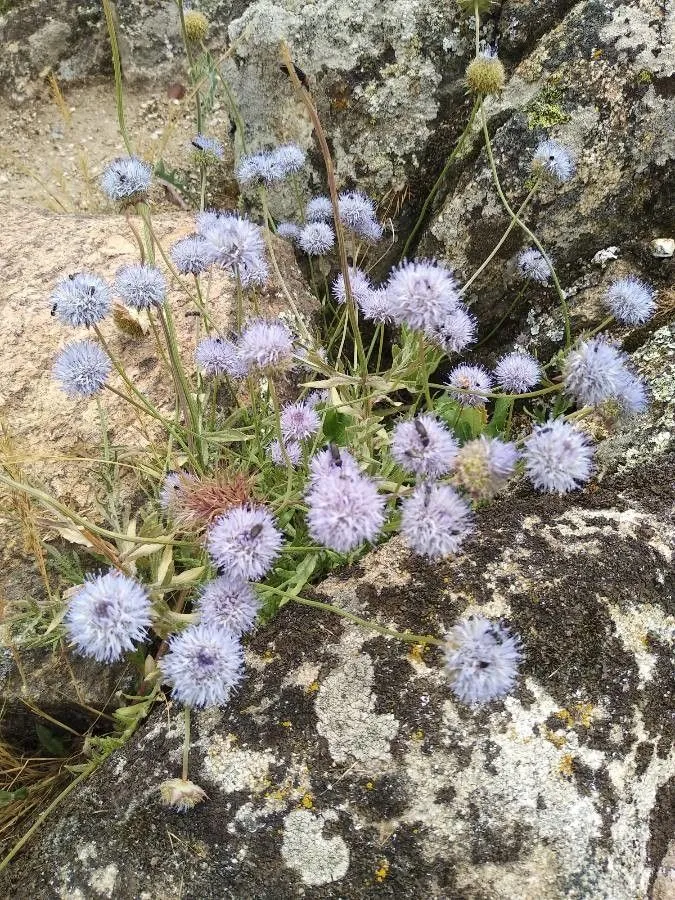
Author: L.
Bibliography: Sp. Pl.: 928 (1753)
Year: 1753
Status: accepted
Rank: species
Genus: Jasione
Vegetable: False
Observations: Europe to NW. Africa
Sheepbit: A Botanical Overview
Sheepbit, scientifically recognized as Jasione montana, is a captivating member of the Campanulaceae family. This charming plant carries historical significance with its nomenclature first officially recorded in 1753 by the renowned botanist Carl Linnaeus in his seminal work, “Species Plantarum.”
Native Range and Habitat
Jasione montana is a resilient species that flourishes across a diverse geographical range, extending from the temperate regions of Europe all the way to the northwestern parts of Africa. This broad distribution underscores the plant’s adaptability to various environmental conditions. Typically found in sandy soils, Sheepbit often adorns heathlands, dunes, and dry meadows, thriving in open, sunlit areas that offer minimal competition from other flora.
Morphological Characteristics
Sheepbit presents itself as a herbaceous perennial or biennial plant. One of the most striking features of Jasione montana is its spherical clusters of delicate, bluish to violet-blue flowers. These flower heads sit atop slender, wiry stems that can reach up to 30 centimeters in height. The leaves of Sheepbit are generally narrow, lanceolate, and form a basal rosette, contributing to the plant’s dainty yet robust appearance.
Horticultural Value
In horticulture, Sheepbit is appreciated for its ornamental qualities. Gardeners often incorporate this plant into rock gardens, wildflower meadows, and borders, where it provides a burst of color and delicate texture. Its preference for well-drained, sandy soils makes it an excellent choice for xeriscaping and other low-water landscaping practices.
Ecological Significance
Beyond its visual appeal, Jasione montana plays a valuable role in its ecosystem. The flowers are a source of nectar and pollen, attracting various pollinators, including bees and butterflies. This interaction not only supports the biodiversity of the region but also ensures the continued propagation of the species through effective pollination.
Conclusion
Jasione montana, or Sheepbit, is an exemplary species within the Campanulaceae family, celebrated for its ethereal beauty and ecological contributions. Its widespread presence from Europe to northwestern Africa highlights its adaptability, making it a beloved subject for botanists and gardeners alike. Whether admired in the wild or cultivated in a garden setting, Sheepbit offers a harmonious blend of aesthetic charm and ecological value.
Dan: almindelig blåmunke, blåmunke
Deu: berg-jasione, berg-sandglöckchen
Eng: sheepbit, sheep’s-bit, sheep’s bit
Fra: jasione des montagnes, jasione ondulée
Nld: zandblauwtje
Swe: blåmunkar, monke, svenska blåmunkar
Cym: clafrllys lleiaf, clefryn, clefryn glas
En: Sheepbit, Sheep’s-bit, Sheep’s Bit, Sheep’s Scabious, Sheep’s-bit Scabious
Be: Букашнік горны
Bg: Планинско вятърче
Ca: Jasíone montana
Kw: Botonyow glas
Cs: Pavinec horský
Da: Almindelig Blåmunke, Blåmunke
Nl: Zandblauwtje
Et: Harilik sininukk
Fi: Vuorimunkki
Fr: Jasione des montagnes, Jasione ondulée, Herbe à midi, Herbe bleue
De: Berg-Jasione, Berg-Sandglöckchen, Berg-Sandrapunzel, Blaue Flockenblume, Sandknöpfchen
Ga: Duán na gcaorach
It: Vedovella annuali, Vedovella annuale
Lt: Kalninė austėja
Gv: Bossan gorrym
No: Blåmunke
Pl: Jasieniec piaskowy
Pt: Baton-azul
Ru: Букашник горный
Sk: Pávinec horský, Pavinec horský
Sv: Blåmunkar, Monke, Svenska blåmunkar
Tr: Kumçanı
Uk: Агалик-трава гірська
Cy: Clefryn, Clafrllys Lleiaf, Clefryn Glas
Taken Jun 6, 2021 by Manuel Barón (cc-by-sa)
Taken Nov 28, 2019 by Lopez Pilar (cc-by-sa)
Taken Jul 21, 2017 by Audrey Maire (cc-by-sa)
Taken May 24, 2018 by Ramon Yáñez (cc-by-sa)
Taken May 6, 2017 by Jose Luis Romero (cc-by-sa)
Taken Aug 4, 2022 by Andrzej Konstantynowicz (cc-by-sa)
Taken Oct 11, 2021 by Radosław Urban (cc-by-sa)
Taken Jul 23, 2021 by Christine Vaufrey (cc-by-sa)
Taken Jun 6, 2021 by Manuel Barón (cc-by-sa)
Taken Jul 16, 2021 by marie-odile Morel (cc-by-sa)
© copyright of the Board of Trustees of the Royal Botanic Gardens, Kew.
© copyright of the Board of Trustees of the Royal Botanic Gardens, Kew.
© copyright of the Board of Trustees of the Royal Botanic Gardens, Kew.
Taken Jul 24, 2021 by Jean-Francois Julien (cc-by-sa)
Taken Aug 8, 2021 by Clara Wagner (cc-by-sa)
Taken Jul 12, 2021 by Pierre LEON (cc-by-sa)
Taken Aug 14, 2018 by bas yves (cc-by-sa)
Taken May 6, 2017 by Jose Luis Romero (cc-by-sa)
Taken Jul 20, 2021 by Darren Giddins (cc-by-sa)
Taken Aug 3, 2021 by Monique TROEL-SYS (cc-by-sa)
Taken Sep 23, 2020 by Frozy
Taken Aug 25, 2021 by Pierre LEON (cc-by-sa)
Taken Aug 14, 2018 by bas yves (cc-by-sa)
Taken May 13, 2019 by Erin Becton (cc-by-sa)
Taken Jun 20, 2012 by Tela Botanica − Emmanuel STRATMAINS (cc-by-sa)
Taken Jul 31, 2021 by Pierre LEON (cc-by-sa)
Taken Oct 21, 2017 by Yoan MARTIN (cc-by-sa)
Taken May 14, 2022 by Sylvain Piry (cc-by-sa)
Taken Oct 21, 2017 by Yoan MARTIN (cc-by-sa)
Taken Jul 27, 2021 by Giode Tonpino (cc-by-sa)
Taken Jul 29, 2014 by Tela Botanica − Richard FAERBER (cc-by-sa)
Taken May 12, 2014 by Tela Botanica − Mathieu Sinet (cc-by-sa)
Taken Jun 12, 2022 by Pauline Mergel (cc-by-sa)
Growth habit: Forb/herb
Ph maximum: 5.0
Ph minimum: 4.5
Light: 7
Atmospheric humidity: 5
Bloom months: [‘jun’, ‘jul’, ‘aug’, ‘sep’]
Soil nutriments: 2
Family: Myrtaceae Author: (F.Muell.) K.D.Hill & L.A.S.Johnson Bibliography: Telopea 6: 402 (1995) Year: 1995 Status:…
Family: Rubiaceae Author: Pierre ex A.Froehner Bibliography: Notizbl. Bot. Gart. Berlin-Dahlem 1: 237 (1897) Year:…
Family: Sapindaceae Author: Koidz. Bibliography: J. Coll. Sci. Imp. Univ. Tokyo 32(1): 38 (1911) Year:…
Family: Asteraceae Author: A.Gray Bibliography: Pacif. Railr. Rep.: 107 (1857) Year: 1857 Status: accepted Rank:…
Family: Fabaceae Author: Medik. Bibliography: Vorles. Churpfälz. Phys.-Ökon. Ges. 2: 398 (1787) Year: 1787 Status:…
Family: Aspleniaceae Author: (Cav.) Alston Bibliography: Bull. Misc. Inform. Kew 1932: 309 (1932) Year: 1932…